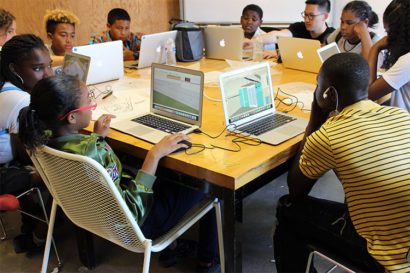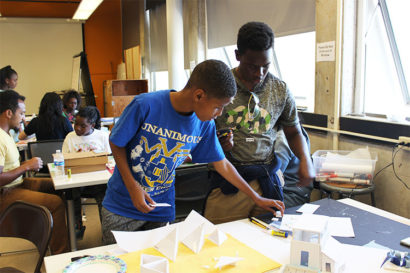An aspiring nanotechnologist emerges from summer camp
Family 1st Architecture Camp, for middle-schoolers, opened up new worlds for Savion Green. Now, he's working to save the world
July 13, 2017

Savion Green (middle) is flanked by architect and volunteer instructor Omar Haque (left) and teacher and volunteer Shalonda Tillman (right). (Photo by Avi Salem)
A bored and somewhat world weary 11-year-old Savion Green thought he knew it all when he enrolled in a summer camp about architecture and design three years ago.
This summer, Green returned to UC Berkeley’s Wurster Hall as an eager mentor to other youth in the Family 1st Architecture Camp, a continuing program for middle-schoolers.
Jeremiah Tolbert and Cameron Toler, alumni of the College of Environmental Design and AIA East Bay members, founded the camp to expose underserved youth to architecture, engineering and construction.
It was launched In partnership with the AIA East Bay and 1st Family Foundation – a locally-focused nonprofit founded by Oakland natives and National Football League players Joshua Johnson, a quarterback with the New York Jets, and Marshawn Lynch, a running back for the Oakland Raiders who earned recognition for his performance with the Cal Bears before turning pro.
Savion has lived in East Oakland, along with some other some tough neighborhoods that he has called home – Crenshaw and Hawthorne in Los Angeles, and the Fillmore in San Francisco. He lost his father to homicide when he was only a year old. It happened near Third and Townsend streets in San Francisco, a block from where Savion lives now.
Dreaming big
Today Savion occupies a very different space, one in which he is mapping out a path to become an engineer, focusing on robotics and nanotechnology in hopes of making the world a better place. His transformation came courtesy of a summer camp.
Shalonda Tillman, now a teacher at Madison Park Academy in Oakland, was Savion’s seventh grade teacher at East Oakland Leadership Academy in Oakland three years ago. When she was asked to corral some students to attend the camp, she chose Savion and a dozen or so others.
“Me and Savion had bumped heads throughout the year, because I was always pushing him to do more, when he thought he had done enough,” she recalls.
So inspired
He concedes: “I was kind of arrogant. School came very easy for me and I was just bored with the stuff I was learning because I already knew it.”
Savion says neither of his choices at the time were appealing: summer classes or camp. He chose camp, even though he was clueless what architecture or engineering even meant. Once there, he learned to use computers to draw and design buildings and even cities. “I was so inspired,” he says.
“I saw the talents in Savion, despite of the wall he had built up,” recalls Tillman. “I realized early on that he loved to draw and he was a critical thinker. I immediately knew his future was bright, but he would be the only one to stop himself.”
No one’s stopping him now.
“She was the only person who encouraged me, and she brought me to this camp – which taught me responsibility, STEM (science, technology, engineering and math), and made me decide to become a mechanical engineer,” says Savion.
“I didn’t do anything special, but expose him to a new opportunity,” says Tillman. “He did everything else, and I am a proud teacher.”
Abandoning the hustle
Frank Worrell, a professor of educational psychology at UC Berkeley’s Graduate School of Education, heads up the school’s Academic Talent Development Program of summer camps for students in grades 6-12. He says Green’s story underscores the value of summer camps and of linking youths’ interests and talents to camp subjects.
Brimming with a passion for design, architecture and robotics, Savion has big plans beyond “the hustle. He’s in the eleventh grade, taking high school classes from home and commuting from San Francisco to Contra Costa College in San Pablo courses.
When he graduates from high school, Savion says he should already have an associate of arts degree “and I can go straight to MIT (Massachusetts Institute of Technology).” Second choice: Stanford University. Third: UC Berkeley.
While Savion aspires to earn a Ph.D. in nanotechnology and to find a cure for cancer, he’s busy taking care of business today. He works two jobs – one is counseling other youths about growing healthy foods and cooking nutritious meals and the other is doing janitorial work for his uncle. This enables him to save money to build robots.
Changing the world
“I plan on starting my own company, selling my own robots, and just make life easier for people with this technology,” he says. “I really want to change the world.”
At the moment, he’s also working on an invention that he only will reveal is a “new form of drone,” and writing a book. Eventually he intends to start his own business and develop a host of new inventions. Also on his to-do list is designing a new form of one-stop rehabilitation centers for homeless people that helps get them off the streets, restore their health, teach them job skills, find them employment and “make their lives better.”
His desire to cure cancer stems from numerous personal losses. “Me and cancer have had a beef for quite a while,” he said. “I really want to get back at cancer for it.”
Getting while giving back

Camp students learned AutoCAD basics to do a little redesigning of Mosswood Park in Oakland. (Photo by Avi Salem)
An architect and camp volunteer for four years, Omar Haque calls the program an amazing opportunity for students to learn from professionals in the field, but for professionals to learn about the community as well.
“I’ve really been able to hone my skills in explaining and communicating architecture to a young audience of students who have never been introduced to the concepts before. They may not realize it now, but this is a form of network building and exposure for these students unlike anything else.”
The camp also helps create innovative designs for local projects. Learning the basics of architectural design, including an introduction to AutoCAD, students spent a week in June redesigning the recreation center at Oakland’s Mosswood Park.
